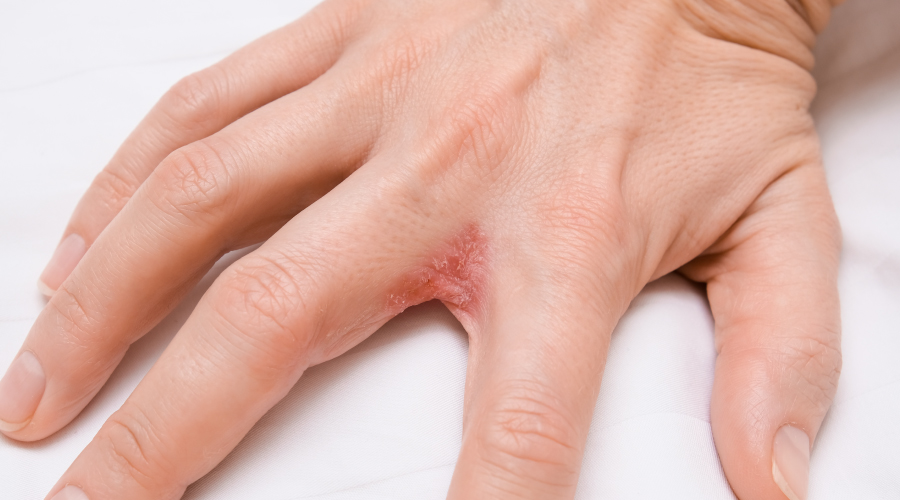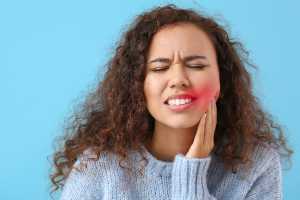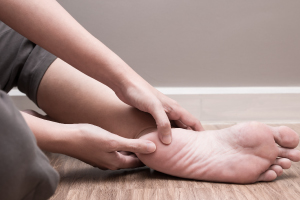

Dyshidrotic eczema is a type of skin disease that generally occurs on the toes and fingertips. Sometimes, it also affects the soles of the feet. The main symptoms of this disease are tiny and uncomfortable blisters, skin flaking, bruising, redness, etc. Keep following the blog to learn more about this skin disease.
Dyshidrotic Eczema Causes
Though the dyshidrosis causes are unknown, there are a few factors that may cause the expansion of this disease:
1. Allergies
In sensitive people, allergic reactions to specific chemicals can cause dyshidrotic eczema. Metal such as nickel or cobalt, perfumes, chemicals, and specific kinds of plants are among the common allergens.
2. Irritants
Irritants can cause dyshidrotic eczema as well. Irritating substances include detergents, chemicals, cleaning products, and various other compounds that come into proximity to human skin.
3. Factors Related to Hereditary Susceptibility
Dyshidrotic eczema typically runs in families, indicating that the condition may be inherited. Specific gene variants may make some people more vulnerable to sickness.
4. Sweating
Dyshidrotic eczema may develop due to excessive sweating or working in warm, muggy surroundings. Sweat is thought to irritate the skin or trigger an inflammatory response.
5. Stress
Eczema may also be caused due to excessive stress and anxiety in specific individuals. Stress can cause hormonal dysfunction that disrupts the immunity system. Therefore, it affects the skin barrier and contributes to the expansion of eczema.
Dyshidrotic Eczema Symptoms
The most frequently affected areas in the body by the symptoms of dyshidrotic eczema, additionally referred to as dyshidrosis, are the palms, fingertips, and toes. Here are some of the dyshidrosis symptoms:
1. Blisters
Blisters are one of the distinctive features of dyshidrotic eczema. They are tiny blisters filled with fluid. Usually, these blisters show up on the toes, both sides of the fingers, the bottoms of the feet, or the palms of the hands. The blisters might have a symmetrical design and are frequently grouped.
2. Itching
Eczema blisters are frequently very irritating and itchy. From minor to severe, this itching might interfere with everyday activities and sleep.
3. Swelling and Redness
The affected skin, especially around the blisters, may swell and turn red. Additionally, the skin in proximity too may seem sensitive or inflamed.
4. Dryness and Cracking
When blisters fade or heal, the skin may become dry and develop cracks or fissures. It could cause pain or discomfort, especially when strolling or employing your fingers for other tasks.
5. Scaling and Peeling
Eczema patients’ skin may experience scaling and peeling, especially during flare-ups or when the blisters recover. The skin could look dry or flaking.
6. Pain or Tenderness
Affected people may face pain and tenderness when skin splits. This is a symptom that occurs at the extreme stage of Dyshidrotic eczema and disrupts your daily life.
You should remember that the symptoms of Dyshidrotic eczema will vary from person to person. Thus, taking professional advice is necessary.
Dyshidrotic Eczema Remedies
Dyshidrotic eczema does not have any proper cure; however, you can manage the symptoms. Depending on the severity of your disease, you can opt for preventive measures. Here are a few dyshidrotic eczema remedies:
1. Moisturisers
You can manage eczema by keeping your skin hydrated and moisturised. Therefore, application of emollients and moisturisers is necessary to prevent dryness and risks of skin flaking.
2. Cool Compresses
Using cool compresses on the affected regions can assist in reducing inflammation, stopping itching, and offering momentary relief. Use a clean, damp cloth after wringing out the excess water.
3. Avoiding Triggers
You should avoid eczema-triggering factors like allergies, irritations, excessive sweating, emotional stress, etc. Reducing exposure to eczema-triggering factors will help you manage the symptoms.
4. Topical Steroids
When this eczema is moderate to severe, topical corticosteroids given by a medical specialist can help lessen swelling, itchiness, and redness.
5. Protective Measures
You should take some protective measures to prevent skin irritations. For example, use gloves when working with anything irritating the skin. If necessary, wear safety shoes while you are exposed to chemicals.
If you notice persistent symptoms of eczema, you must consult a dermatologist to get a complete diagnosis and personalised treatment. With the help of professionals, you will be able to manage your skin conditions.
Conclusion
Dyshidrotic eczema or dyshidrosis is quite annoying as it hampers your daily life and can be triggered by activities like sweating, washing dishes or clothes, etc.
Having said that, people experiencing dyshidrotic eczema can manage their symptoms and lessen their severity by recognising their triggers and adopting basic skin care techniques. Treatments, including topical steroids, moisturisers, cool compresses, etc., are really helpful in managing eczema. However, in extreme cases, serious medical attention will be necessary.




